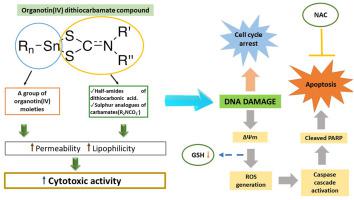Food and Chemical Toxicology ( IF 3.9 ) Pub Date : 2022-08-10 , DOI: 10.1016/j.fct.2022.113336 Sharifah Nadhira Syed Annuar 1 , Nurul Farahana Kamaludin 1 , Normah Awang 1 , Kok Meng Chan 1

|
The novel di-and triphenyltin(IV) dithiocarbamate compounds represented as RnSnL2 (where R = C4H9, C6H5; n = 2,3; L = N,N-dithiocarbamate), Ph2Sn(N,N-diisopropyldithiocarbamate) (OC1), Ph3Sn(N,N-diisopropyldithiocarbamate) (OC2), Ph2Sn(N,N-diallyldithiocarbamate) (OC3), Ph3Sn(N,N-diallyldithiocarbamate) (OC4), and Ph2Sn(N,N-diethyldithiocarbamate) (OC5) were assessed for their cytotoxicity in K562 human erythroleukemia cells. All compounds inhibited the growth of cells at low micromolar concentrations (<10 μM), and the mechanism underlying their antiproliferative effects on K562 cells was apoptosis, as corroborated by the exposure of plasma membrane phosphatidylserine. OC2, which showed the most promising antiproliferative activity, was selected for further analyses. The results demonstrated that OC2 induced apoptosis in K562 cells via an intrinsic mitochondrial pathway triggered upon DNA damage, an early apoptotic signal. Subsequently, OC2 produced excessive intracellular reactive oxygen species. The role of oxidative stress was corroborated by the significant reduction in GSH levels and percentage of apoptosis in NAC-pretreated cells. OC2 could arrest the cell cycle progression in the S phase. These new findings elucidate the antiproliferative potential of OC2 in the K562 human erythroleukemia cells and warrant further investigation, specifically to determine the exact signaling pathway underlying its antileukemic efficacy.
中文翻译:

三苯基锡 (IV) 二硫代氨基甲酸酯化合物主要通过线粒体介导的细胞凋亡在 K562 人红白血病细胞中诱导基因毒性和细胞毒性
新的二和三苯基锡(IV)二硫代氨基甲酸盐化合物表示为 R n SnL 2(其中 R = C 4 H 9,C 6 H 5;n = 2,3;L = N,N-二硫代氨基甲酸盐),Ph 2 Sn( N , N-二异丙基二硫代氨基甲酸酯)( OC1 ),Ph 3 Sn( N , N-二异丙基二硫代氨基甲酸酯)( OC2 ),Ph 2 Sn( N , N-二烯丙基二硫代氨基甲酸酯)( OC3 ),Ph 3 Sn( N, N-二烯丙基二硫代氨基甲酸盐) ( OC4 ) 和 Ph 2 Sn( N , N-二乙基二硫代氨基甲酸盐) ( OC5 ) 在 K562 人红白血病细胞中的细胞毒性进行了评估。所有化合物在低微摩尔浓度 (<10 μM) 下均抑制细胞生长,其对 K562 细胞的抗增殖作用的机制是细胞凋亡,这已通过质膜磷脂酰丝氨酸的暴露得到证实。选择显示出最有希望的抗增殖活性的OC2进行进一步分析。结果表明,OC2通过 DNA 损伤触发的内在线粒体途径诱导 K562 细胞凋亡,这是一种早期凋亡信号。随后,OC2产生过多的细胞内活性氧。NAC预处理细胞中GSH水平和细胞凋亡百分比的显着降低证实了氧化应激的作用。OC2可以在 S 期阻止细胞周期进程。这些新发现阐明了OC2在 K562 人红白血病细胞中的抗增殖潜力,值得进一步研究,特别是确定其抗白血病功效的确切信号通路。





















































 京公网安备 11010802027423号
京公网安备 11010802027423号